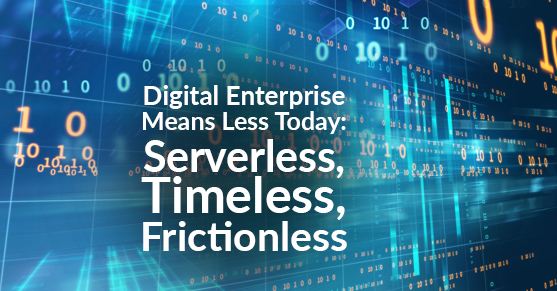Next-level enterprise requires next-level technologies, including cloud technologies, cognitive systems, hyper-personalized user experiences, intelligent bots, augmented reality and messaging platforms that deliver relevant messaging in seconds. We are entering a world of ambient technology, where the computer becomes invisible and unobtrusive as the environment becomes more intelligent. For large-scale enterprises, it’s about delivering frictionless value to customers and users. For IT teams, it’s about doing more with less.
The marketing technology stack is continuing to evolve, with nearly 7,000 tools now available to enterprises, according to Chief Marketing Technologist. Customers are savvier than ever and expect their brand experiences to match their last best experience (compete with Amazon, anyone?). Employees and users need to be at peak performance more than ever to meet assertive-to-be-competitive organizational targets.
While analyst firm Gartner forecasts that enterprise IT spending will grow by 6.2% globally in 2018, the reality is that enterprises are being pushed to work smarter with their resources. And that means less is more when it comes to being successful in today’s competitive market — less servers, less expense, less personnel spend, less data fragmentation, less time to market — while user and customer needs, technology options and data exchanges and instant personalization are on the rise.
Opportunities For Digital Enterprise
Let’s consider how this ‘perfect storm’ is creating opportunities for digital enterprise today.
Visionary enterprises are adopting application programming interface (API)-led connectivity, which is based on thinking in terms of mirroring real-world business outcomes and connecting data to applications through reusable and purpose-built APIs. These APIs enable you to expose data hidden away in your siloed systems and applications, compose and orchestrate processes, and help deliver the end-user experience. The opportunity here is that IT teams can be attuned and aligned with business processes and performance targets, breaking down operational and data silos and facilitating the optimal (i.e., frictionless) technology for users and customers.
Serverless computing is next-level cloud technology, in that it removes the burden of considering IT infrastructure from the developer and the operations team. It’s changing how IT thinks, from server to virtual machine to container to function — for example, creating and using APIs to perform a complex string of triggered actions across multiple systems without having to worry about the administrative overhead of creating, managing, maintaining and scaling the infrastructure required to provide those APIs. Your team’s effort can be focused solely on developing application functionality, and thereby addressing business needs.
Additionally, you can leverage more and more as-a-service offerings like identity as a service (IDaaS), content as a service (CaaS) and others, along with serverless computing, to achieve efficiencies via less code that developers need to write from scratch, saving enterprises time, energy and resources.
Since customer experience is the only sustainable advantage in business today, connection with customers — and users — through all relevant touch points must be always on and ever available, delivering personalized information and results on demand. In other words, successful business is timeless.
Now for the big kahuna, regardless of all other technological requirements for digital enterprise today: being frictionless. What does that mean? Essentially, customers and business users expect technology to work without disruption and without being overtly noticeable.
As Phil Wainewright, author of The XaaS Effect explained in an article on Diginomica, “Today’s connected digital infrastructure has completely transformed the economics of those transaction costs, fundamentally changing the equilibrium of the enterprise. Much of the friction caused by time, distance and lack of information has been swept away, forcing a complete recalculation of the cost-benefit analysis that led to the creation of the twentieth-century enterprise.”
Historically, friction was caused by time, distance, fragmented marketing tech stack, a lack of information, immaterial content, institutionalized habits, redundant information capture, piecemeal customer profiles, and slow deployment. But today’s technology has solved most, if not all, of these challenges, so enterprises can be more streamlined, timely and relevant. The time it takes to deliver a stellar customer experience has been compressed; the corresponding resources have been minimized as well.
Next-Level Challenges In Frictionless IT
What are the current next-level challenges in frictionless IT? There are four, as follows:
- Business users have exceptional experiences with personal IT (Gmail, Dropbox, etc.) and expect the same kind of intuitive, fast, omnichannel, frictionless experience with enterprise IT.
- The younger generation entering the workforce knows only frictionless computing and may be less tolerant of cumbersome, complicated enterprise IT.
- Digital transformation is disrupting the status quo by fostering customer-centricity and redefining business models to adapt to dynamic customer conversations which, in turn, influences organizational technologies.
- The skills challenge in enterprise IT that seems to keep increasing with the rapid pace of innovation is having a deep pool of problem-solvers who are not only competent in but capable of shaping and molding the new frictionless IT. This particular challenge can manifest itself in the need to essentially transform your IT team’s culture.
The benefit of “less” in digital enterprise means having more resources to allocate in delivering an ever-evolving customer and user experience, developing innovative solutions and creating next-level opportunities. Be less reasonable in your expectations and aspirations. Challenge the status quo. And dare to dream.
This post was originally published for Forbes Tech Council

